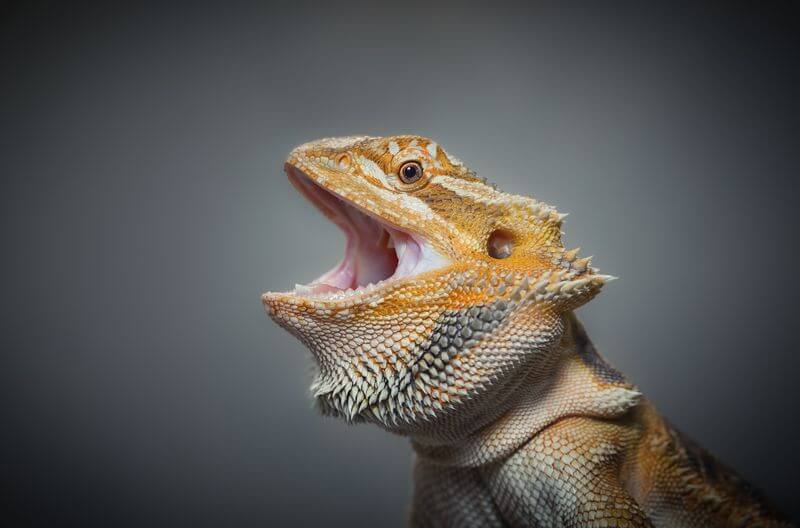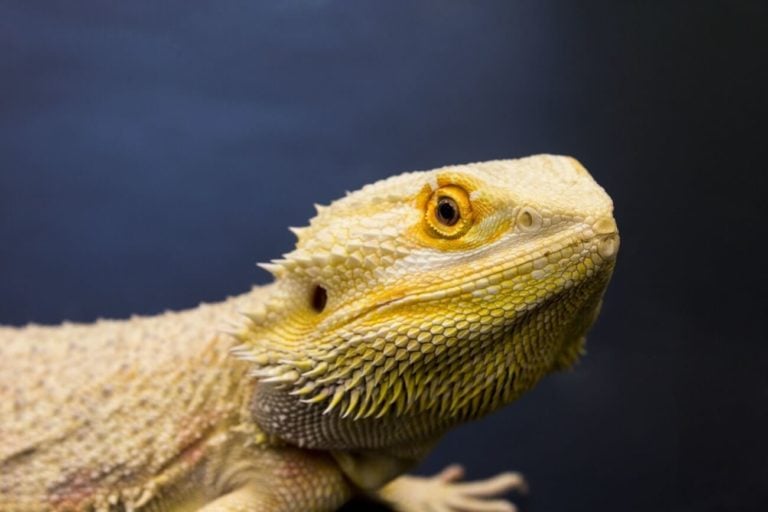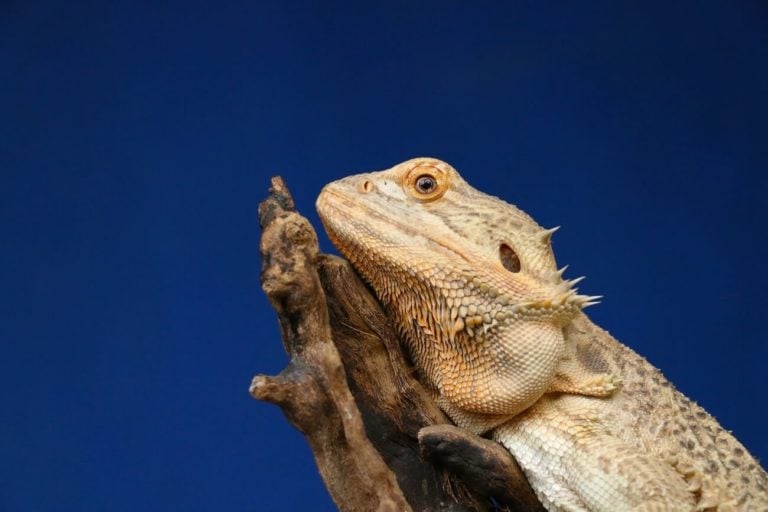Bearded dragon mouth rot is something that many owners are concerned about, but many don’t actually know much about it!
This guide goes over what mouth rot is in bearded dragons, why it happens, and how you can protect your pet.
Table of Contents
What Is Bearded Dragon Mouth Rot?
Mouth rot is a condition that can affect bearded dragons at any age. Also known as infectious or ulcerative stomatitis, it’s a bacterial infection that causes swelling, irritation, discharge, and more. It occurs when bacteria in the mouth proliferate and enter the lizard’s system through physical injury.
Bearded dragon mouth rot is relatively common, but that doesn’t mean you can afford to ignore it. While the irritation initially starts mild, mouth rot can worsen the longer you don’t treat it. It has the potential to cause far-reaching health problems and eventual death.

Reptiles like the bearded dragon are tough, but bacterial infections like this can be debilitating. That’s why it’s crucial to take action and seek veterinary care as soon as possible.
Health Complications It Can Cause
When a bearded dragon experiences mouth rot, it’s only the beginning of many potential health problems if left untreated. Bacteria can wreak havoc on your beardie’s body in many ways.
While mouth rot usually starts with the bacteria causing inflammation of the tissue, it quickly spreads to the tongue, jaw, and teeth. Many bearded dragons suffer dental decay, losing teeth to the infection as it spreads. The entire jaw and head can also suffer as the bacteria move from the stoma to the rest of the body.
It doesn’t stop there. Infections can go viral, affecting many biological processes. Untreated mouth rot can turn into intestinal damage, organ failure, and more. It can even get into the bloodstream, resulting in the eventual shutdown of many bodily functions.
It is possible for mouth rot to be fatal, and it spreads quicker than most realize. Ignoring the early signs will only increase your bearded dragon’s risks moving forward.
Symptoms
Fortunately, bearded dragon mouth rot is one of the easier health conditions to spot. It has a wide range of symptoms and often causes noticeable behavior changes.
Here are the main symptoms to look out for.
1. Appetite Loss
When an infection ravages your bearded dragon’s mouth, the last thing they want to do is eat. These creatures are already notorious for being picky with food, but that behavior will increase exponentially when mouth rot is in the mix.
Many beardies with mouth rot ultimately lose weight and become lethargic due to the lack of energy. Some will refuse to eat so much that they start to experience seizures as the body shuts down.
Expert Tip: That disinterest in food also can apply to water. Bearded dragons prefer to get their water from food, so many become dehydrated and suffer the consequences that come with it.
2. Visible Changes
The inside of a bearded dragon’s mouth will change dramatically when dealing with mouth rot. Instead of the pink coloration you’re used to seeing, you’ll notice the oral cavity take on a gray or yellow appearance. Pus-filled pustules and sores may also develop.
Swelling is also common. The immune system sends cells to fight the infection, resulting in noticeable inflammation that causes the mouth cavity to puff up. The swelling can get so bad that your beardie has difficulty closing their mouth.
Expert Tip: The inflammation can also move to the gums and the rest of the face, making your bearded dragon’s head look plumper than normal.
3. Discharge
Unfortunately, discharge can occur once mouth rot progresses. Those pus-filled pustules pop, and a mix of cells and bacteria-ridden fluids can flow out.
The discharge can mix with the saliva, creating a dangerous cocktail of foul-smelling liquid. Your bearded dragon can experience discharge from the eyes and nostrils as the infection progresses.
4. Excessive Drooling
Bearded dragons aren’t known for drooling. They may let some saliva drip down their mouths when eating, but outside of that, these reptiles typically keep their mouths dry.
When mouth rot in bearded dragons occurs, they can’t help but drool. Many beardies have trouble closing all or part of the mouth, allowing saliva to spill out. In many cases, the saliva becomes thick and discolored as it mixes with discharge.
The Cause Of Mouth Rot In Bearded Dragons
Mouth rot in bearded dragons can occur for many reasons. It’s easier for infection to take over than most realize, and simple things in your beardie’s life or environment can pave the way for this health issue.
Environmental Factors
One of the most common challenges when raising bearded dragons is maintaining a healthy habitat setup. These creatures are native to arid regions of Australia. Most standard home conditions aren’t suitable for its lifestyle and health.
That’s why reptile enthusiasts go to great lengths to create a simulated environment with the proper temperature, humidity, lighting, and more.
When those conditions aren’t right, bearded dragons experience massive stress. Their health declines and mouth rot is often a common sign that something’s wrong.
Expert Tip: The biggest culprits are temperature and humidity. Invest in high-quality hygrometers and thermometers. Maintain a healthy temperature gradient with a basking lamp and a cool side. It’s also necessary to have UVB lights for exposure.
Use your hygrometer to keep humidity levels high, and take steps to keep everything within a healthy range.
Unsanitary Living Conditions
Another cause of bearded dragon mouth rot is a poorly cleaned habitat. Your bearded dragon lives in a confined space where bacteria can flourish. If you’re not keeping the enclosure clean, it’s only a matter of time until your lizard’s health declines.
Bacteria can quickly spread onto any surface of the tank. Mites and parasites may become a problem, too.
It’s necessary to deep clean the enclosure every few weeks. Sanitize every surface, replace any soiled substrate, and take steps to minimize the spread of bacteria.
Weakened Immune System
Mouth rot in bearded dragons is often a secondary infection that points to other underlying health problems. When their body works to fight off another illness, it doesn’t have the strength to keep dangerous bacteria at bay.
The immune system must focus on other matters, leaving bacteria in the mouth to multiply and cause infection. General immunity problems can also lead to mouth rot. Bearded dragons can suffer from a weak immune system when they have a lackluster diet that doesn’t meet their nutritional needs.
Physical Injuries
Finally, mouth rot can occur due to minor cuts and abrasive injuries. Bacteria exist in your bearded dragon’s mouth and environment already. When they experience an injury, that bacteria can enter your beardie’s body and wreak havoc on their system.
The mouth tissue is relatively delicate, and your lizard can experience injuries in many ways. They can cut themselves eating the tough exoskeleton of an insect or when accidentally eating substrate. Either way, those injuries provide an easy entry point for bacteria.
How To Treat It
Mouth rot can turn into a disaster if left unaddressed. Luckily, there are many ways to treat it. What you do to treat mouth rot will depend on the severity of the case and veterinary recommendations, but here are a few things you can do.
Quarantine And Clean
If you have more than one bearded dragon living in the same enclosure, you first need to quarantine the infected lizard. The bacteria that cause mouth rot can spread to others, creating a more significant problem you don’t want to battle.
Place the beardie with mouth rot in a separate tank. Then, take steps to clean the enclosure. Bacteria is at the heart of mouth rot, and cleaning can make a big difference.
At-Home Treatment
If you can’t get to a vet immediately, consider using povidone-iodine or chlorhexidine diacetate. These antiseptic solutions are usually available at pet stores or human pharmacies.
Dilute the solution of your choice in water and use a cotton swab to apply it to your bearded dragon’s infected mouth. Cleanse the area twice a day for the first few days. When you use a cotton swab, remove any discharge.
Antibiotics
The best way to treat mouth rot in bearded dragons is with antibiotics. These medications help to kill the disease-causing bacteria, preventing the spread of infection and restoring your lizard’s health.
Depending on the case, your vet may prescribe topical or oral antibiotics. Always follow their instructions and avoid self-prescribing any medications. Only use antibiotics under the supervision of a vet who specializes in reptiles.
How To Prevent Mouth Rot In The Future
The best thing you can do to avoid bearded dragon mouth rot in the future is to be vigilant about providing the best care possible.
Most cases of mouth rot arise after habitat conditions fail to meet the lizard’s needs. Improper temperature, humidity levels that are too high or too low, and filthy living conditions are all common causes.
Invest in the right equipment to monitor environmental factors and keep your beardie’s habitat comfortable. Create a cleaning routine and stick to it! It can be easy to assume that your pet is “fine” when environmental parameters fall out of the preferred range.
But your beardie will suffer the longer those issues persist. The same goes for dietary problems. Invest in high-quality foods, healthy supplements, and more to keep your beardie’s immune system in check. Be vigilant about providing the best care possible, and mouth rot won’t be an issue.
When To Visit A Vet
Ideally, the best time to visit a vet is whenever you first notice the signs of mouth rot in your bearded dragon.
Infections can stem from many internal health problems. Furthermore, uncomplicated infections can actually be tumors or other issues. Vets can examine your little pal, diagnose mouth rot, and determine the best course of action.
Vets can also prescribe the most effective mouth rot treatment: Antibiotics. Misusing this medication is easy, and you need veterinary guidance to administer it correctly.
Time is of the essence with mouth rot infections. Visit a vet as soon as possible to minimize the damage and bring your lizard back to good health.
Wrapping Up
Mouth rot in bearded dragons isn’t something to be afraid of, as long as you’re providing them with top-notch care. However, it’s still a good idea to understand this illness so you can act quickly if it strikes in the future.
We hope you found this guide helpful! If you have any questions about it, you can always let us know.


